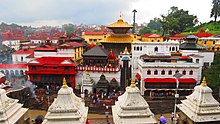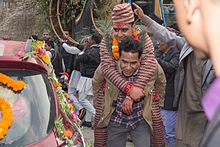Religion in Nepal
This article has multiple issues. Please help improve it or discuss these issues on the talk page. (Learn how and when to remove these template messages)
|
Religion in Nepal (2021)[1]



Religion in Nepal encompasses a wide diversity of groups and beliefs.
Nepal has the highest number of followers of Hinduism and Buddhism religions. These are the two religions that have the most adherents in Nepal.In 2011, these two religions represented 81.3% and 9.04% of the national population respectively. Second only to India, Nepal is also home to one of the largest Hindu populations in the world.[6][7]
The majority of prominent Hindu pilgrimage sites are located in this nation.
Nepal is the birthplace of Siddhartha Gautama (the Buddha). As such, Buddhism has a special place in the country and is often intertwined with Hinduism among some communities.[7][13] Nepal is a multicultural, multi-ethnic, multilingual, and multi-religious nation through democracy.[14][15]
The Nepali constitution guarantees freedom of religion. Forced conversion from Hinduism to other religions is against the law, especially when money is used as a direct or indirect incentive to convert. However, anyone can choose to change their religion on their own. Nationalists have sometimes protested against
History

Hinduism is present in Nepal since the beginning of recorded history in the area. Muslims came to the country around the 11th century and brought Islam with them. Sikhism came to Nepal during the 18th century and spread throughout Nepal, and Jainism came to Nepal during the 19th century but spread only to Kathmandu and some districts of Nepal.
Religious tolerance can be found in royal orders dated Falgun Sudi 12, 1884
Our father (i.e. King Girban) has issued a copper plate inscription declaring that nobody shall harass you so long as you observe traditional religious practices (dharma). We hereby reconfirm that order.
According to the 2011 census, 81.3% of the Nepalese population is
In 1971, Hindus made up 89.4% of the population, Buddhists 7.5%, and Kirants statistically, 0%. However, the prevalence of dual-faith practices - particularly among Hindus and Buddhists - complicates statistics on religious groups.
At the beginning of the 1990s, Hindus made up at least 87% of the population in every region. The largest concentrations of Buddhists were found in the eastern hills, the
Secularism
Nepal was declared a
In 2023, the country was scored 2 out of 4 for religious freedom.[23]
The five main provisions of secularism in Nepal are as follows:[24]
1) A clause that says, "Religious and cultural freedom, with the protection of religion and culture practiced since ancient times," This has been questioned by some people, who say that it indirectly favours "Hinduism" as a state-sponsored religion.[25]
2)
3) Critics say that the constitution discriminates against women in terms of passing on citizenship rights, and the citizenship policy was hotly debated during the drafting of the constitution.[26]
4) It is against the law for the state and the courts to treat people differently because of their sexual orientation or gender identity. The constitution of Nepal has been an inspiration for Asia and beyond the world to specifically protect the rights of
5) The
Demographics
| Religion | Population
% 1952/1954 |
Population
% 1961 |
Population
% 1971 |
Population
% 1981 |
Population
% 1991 |
Population
% 2001 |
Population
% 2011 |
Population
% 2021 |
|---|---|---|---|---|---|---|---|---|
| Hinduism | 88.87% | 87.69% | 89.39% | 89.50% | 86.51% | 80.62% | 81.34% | 81.19% |
| Buddhism | 8.59% | 9.25% | 7.50% | 5.32% | 7.78% | 10.74% | 9.04% | 8.21% |
| Islam | 2.54% | 2.98% | 3.04% | 2.66% | 3.53% | 4.20% | 4.39% | 5.09% |
| Kirat | N/A | N/A | N/A | N/A | 1.72% | 3.60% | 3.04% | 3.17% |
| Christianity | N/A | N/A | 0.02% | 0.03% | 0.17% | 0.45% | 1.41% | 1.76% |
| Others/Unspecified | 0.01% | 0.07% | 0.05% | 2.49% | 0.28% | 0.39% | 0.78% | 0.58% |
| Religion | Population | Percentage |
|---|---|---|
| Hinduism | 23,677,744 | 81.19% |
| Buddhism | 2,393,549 | 8.2% |
| Islam | 1,483,054 | 5.03% |
| Kirat | 924,204 | 3.17% |
| Christianity | 512,313 | 1.76% |
| Others | 173702 | 0.65% |
| Total | 29,164,578 | 100% |
Hinduism in Nepalese culture


According to Nepalese theology, Brahma, Vishnu and Shiva came to Nepal in the form of deer.[32]
Establishment of Nepal by Ne Muni
King Muni used to perform religious ceremonies at Teku, the confluence of the Bagmati and Bishnumati rivers.
Flag of Nepal
The current flag of Nepal was established in 1962. It depicts a white moon and crescent shape emitting eight rays above a white sun which emits 12 rays.[34]
See also
- Buddhism in Nepal
- Newar Buddhism
- Banishment of Buddhist monks from Nepal
- Hinduism in Nepal
- Newar Hinduism
- Gurung shamanism
- Islam in Nepal
- Nepali Muslims
- Judaism in Nepal
- Christianity in Nepal
- Roman Catholicism in Nepal
- Jainism in Nepal
- Bahá'í Faith in Nepal
- Sikhism in Nepal
- Irreligion in Nepal
- Freedom of religion in Nepal
References
- ^ a b "नेपालमा ८१ प्रतिशत हिन्दु, क्रिश्चियन २ प्रतिशत भन्दा कम".
- ^ Interim Constitution of Nepal - Equal Rights Trust
- ^ "The Interim constitution of Nepal (2015), privileges Hinduism as the state sponsored religion". Scroll In. 20 September 2015. Archived from the original on 2021-07-19. Retrieved 2021-05-06.
- ^ "Constitution of Nepal". Nepal Law Commission. Archived from the original on 2021-07-14. Retrieved 2021-07-21.
- ^ "A history of religion in Nepal". Archived from the original on 2021-07-09. Retrieved 2021-07-21.
- ^ World Atlas, 2019 report, Retrieved 2023-04-26
- ^ a b "South Asia : Nepal". The World Factbook. Central Intelligence Agency. Archived from the original on 2021-01-09. Retrieved 2019-07-01.
- ^ "Visit the "Guardian Deity of the Himalayan Country" Pashupatinath". The Sun Tribune. Retrieved 2024-01-05.
- ^ "10 UNESCO World Heritage Sites of Nepal". Adventure Holidays in Nepal. 2017-06-29. Archived from the original on 2019-07-01. Retrieved 2019-07-01.
- ^ "Cow becomes national animal of Nepal". News18. 21 September 2015. Archived from the original on 2019-07-01. Retrieved 2019-07-01.
- ^ "Sanctity of the cow: Hinduism". Encyclopedia Britannica. Archived from the original on 2019-07-01. Retrieved 2019-07-01.
- ^ Ojo, Kehinde (2 November 2018). "Nepal's Cattle Slaughter Ban: Impacts on Dairy Producers' Profit". Agrilinks. Archived from the original on 1 July 2019. Retrieved 1 July 2019.
- ^ "Same Same But Different: Religion in Nepal". Inside Himalayas. 2018-06-20. Archived from the original on 2021-02-01. Retrieved 2019-07-01.
- ^ "Is Nepal a Hindu state or secular?". Ucanews.com. Archived from the original on 2019-07-01. Retrieved 2019-07-01.
- ^ "Nepal Adopts New Constitution, Becomes a Secular State: 5 Facts". NDTV. Archived from the original on 2020-11-12. Retrieved 2019-07-01.
- ^ "Religious freedom in Nepal 'teetering on the edge'". World Watch Monitor. 23 October 2017. Archived from the original on 2021-02-04. Retrieved 2019-07-31.
- ^ "Nepal minister supports demand to declare country a Hindu state". The print. 31 March 2022.
- ^ Regmi 1987, p. 18.
- ^ "MUSLIMS of NEPAL: Becoming an assertive minority". October 13, 2007. Archived from the original on August 3, 2019. Retrieved August 3, 2019.
- ^ Ochab, Ewelina U. "Nepal's Protection Of Religious Freedom On Downward Spiral". Forbes. Archived from the original on 2018-03-24. Retrieved 2018-03-23.
- ^ Christian Solidarity Worldwide, 2022 report
- ^ "Nepal party demands government to declare country as Hindu state, revoke secularism". Outlook India. Archived from the original on 2021-05-06. Retrieved 2021-05-06.
- ^ Freedom House, retrieved 2023-08-08
- ^ "Nepal Adopts New Constitution, Becomes a Secular State: 5 Facts". ND TV. Archived from the original on 2020-11-12. Retrieved 2019-07-01.
- ^ "Nepal's new constitution comes into force on Sunday, but minorities say it privileges Hindus". Scroll. 20 September 2015. Archived from the original on 2021-07-19. Retrieved 2021-05-06.
- ^ "Nepal's unequal Citizenship Law". Nepali times. 19 December 2020. Archived from the original on 2021-05-06. Retrieved 2021-05-06.
- ^ "How Did Nepal Become a Global LGBT Rights Beacon?". HRW. 11 August 2017. Archived from the original on 2 May 2021. Retrieved 6 May 2021.
- ^ "In Nepal, the rhino evokes national pride". Monga bay. August 2017. Archived from the original on 2021-05-06. Retrieved 2021-05-06.
- ^ "Population Monograph of Nepal Volume II (Social Demography)" (PDF). Archived (PDF) from the original on 2021-11-26. Retrieved 2020-11-25.
- ^ "नेपालमा ८१ प्रतिशत हिन्दु, क्रिश्चियन २ प्रतिशत भन्दा कम". Online Khabar. Retrieved 2023-06-02.
- ^ https://censusnepal.cbs.gov.np/results/files/caste/Religion_NPHC_2021.xlsx National Statistics Office.
- ^ History of Nepal: With an Introductory Sketch of the Country and People of Nepal, Daniel Wright
- ^ a b "The Ancient Period", Nepal, Info club, archived from the original on 2008-05-24, retrieved 2008-07-08
- ^ "Flag of Nepal". Encyclopedia Britannica. Archived from the original on 2020-11-18. Retrieved 2019-07-31.
Sources
- Regmi, Mahesh Chandra (1987), Regmi Research Series, vol. 19, Regmi Research Centre
